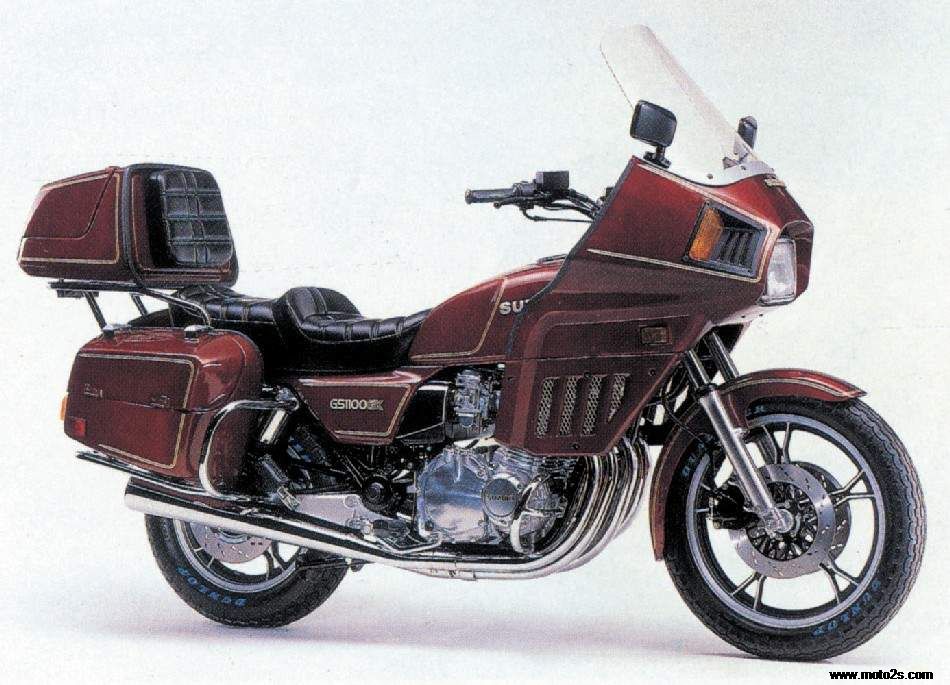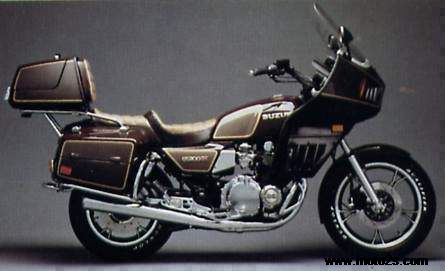Suzuki GS 1100GK
Cruise down any interstate highway and chances are the bike you'll most often see will be Honda's GL1100 Interstate. What's more, most of the bikes that aren't Interstates will be sporting fairings from Vetter, or one of its competitors, and toting luggage. Once you recognized that, if you were a decision-maker for one of Honda's three major competitors, dollar-sign neon lights would brighten in your head, and you would do what Suzuki has done with the GS1100GK. Like Honda's Interstates, the GS-1100GK is a factory-built, full-boat tourer. Based on the recently introduced 1100cc shaft-drive model, the GK includes a full fairing, saddlebags, and a trunk, all built and fitted in Japan. It uses the same frame, eight-valve engine, drive train, and other basic components as the bare 1100G (tested in our April '82 issue), but has a few pieces all its own, such as a different saddle and air shocks. The GS1100GK is Suzuki's first attempt at building a full-dress tourer. Previous luggage and fairings offered by U.S. Suzuki were the standard offerings of American accessory companies, with Suzuki colors and decals added. However, when setting out to build its own touring gear, Suzuki didn't deviate much from the conventional designs of the products they had been buying from U.S. manufacturers. The full fairing, for example, follows the general lines established by Vetter and copied by almost everybody. It's made of the usual injection-molded ABS plastic. It has removable lowers, built-in front turn signals, a headlight-adjustment knob in the cockpit for the rectangular headlamp, locking storage pockets on each side of the interior, a non-locking compartment on the right, and removable panels to permit installation of the Clarion radio, speakers, etc. to be offered in 1983. The streamlined mirrors also mount to the fairing. There are, however, some features offered on other touring fairings that we missed on the GK; it has no vents of any kind, no map-holding feature, and no provisions for adjusting the height of the Lexan acrylic windscreen. However, a slightly shorter windscreen may be offered as an option. Unlike Honda's hard-coated Interstate windscreen, the GK's windscreen is easily scratched by dirt or a gas station paper towel. We also discovered that gasoline will attack the windshield. We learned this when, after overfilling the fuel tank, the excess gas blew onto the inside of the windscreen as we got up to speed again. After it was wiped off, the windscreen had a fogginess that impaired vision, a condition that finally caused us to replace the windscreen. The Suzuki fairing provides wind protection on a par with other large frame-mounted bug-bumpers. The rider's torso, arms, legs, and even his feet are well shielded. A five-foot-nine rider can sit normally and completely escape the wind's blast and any turbulence around his helmet, although he can't see over the windshield—a problem when it is wet or dirty. A five-foot-eleven rider can see over the top of the windshield, but has to put up with some wind noise and a small amount of buffeting. The same trade-off exists with virtually all similar fairings. We appreciated the fairing's excellent wind protection when the weather was cool or moderate. The air is quite still behind it, and there is no rushing-in effect to push you forward at high speed. However, the bike is uncomfortably hot when the temperature is above 75 degrees. It's hotter than most similarly faired bikes for a couple of reasons. One is the lack of vents. However, the heat from the engine, which escapes around your upper legs and waist, was a bigger problem. We feel that a shield around the engine—like the ones Vetter uses on most of their vertical-multi applications—would be a major improvement. All faired bikes trap some heat near the rider, but the problem seems to be greater on the 1100GK, and the heat actually makes it unpleasant to ride in warm weather. This was probably our biggest complaint about the GK; removing the fairing's lowers only partially solved the problem. The fairing also amplifies engine noise. The raised noise level makes it seem as though the engine revs too high; we were constantly trying to find a higher gear. The Suzuki saddlebags are non-detachable and include built-in turn signals. The doors' hinges are located about halfway down the outboard sides, so the doors swing out. This system offers a reasonably sized opening without letting the contents fall out. Each bag is rated at 20 pounds and offers adequate capacity, but won't hold a helmet. Two locks secure each door, and the ignition key operates all luggage and fairing locks. Although the locks are adequate, the bags and trunk are somewhat flimsy. It's possible to pry the doors open with your hands, especially on the trunk, and a thief could snap the doors off to get the contents. The trunk is quick-detachable. There's a handle on its top and a padded backrest for the passenger on its front. The hinges for its cover are located on the top, and it swings up and forward to open. There's room enough for one full-face helmet inside, although helmets stowed in the trunk were usually scratched by the cover's hinges. The trunk is located fairly high and rearward, and the tail section gets in the way. Without the tail section, the trunk could be more ideally placed. The trunk's location makes the GK a bit wheelie-prone. More importantly, it makes the handling shaky below 30 mph, especially when turning. This low-speed oscillation is typical of bikes with a trunk mounted high and far back. The trunk's location probably also contributes to the GK's sensitivity to rain grooves and its wallowing during highspeed (over 80 mph) cornering. In general, the GK feels wallowy, slow to respond, and a bit unsteady, even with its air shocks (which do not share a common filler valve) and fork pumped up to maximum pressures. These handling faults are common on bikes equipped with aftermarket fairings and luggage, but they have been almost completely avoided in the only other Japanese-built dresser, the Honda GL1100 Interstate/ Aspencade. The Honda 1100 also boasts brakes that retain their considerable stopping power through hard use. But the Suzuki can claim more cornering clearance. If anything, the 98 pounds added by the GK's fairing and luggage improve suspension compliance because they increase the ratio of sprung to unsprung weight. The GK's air shocks probably also contribute to the bike's ability to absorb all sizes and shapes of bumps without disturbing the rider. Except for the suspension compliance and the fairing's wind protection, the GK is less comfortable than the plain G-model. The GK's special seat seems thinner, has sharper edges, and because of its dividing hump, is less roomy than the G's saddle. Our GK also vibrated more than our G—enough to annoy some of our testers. The mighty 1100G power plant is not intimidated by the extra weight and wind resistance of the GK's equipment. The big GS engine zipped the GK through the quarter-mile in 12.69 seconds, with a terminal speed of 104.4 mph. The Honda GL1100 Aspencade, run on a better day, could only manage a best run of 12.999 seconds at 99.1 mph. The bare GS1100G rolled through in 11.88 seconds at 112.3 mph. There's also plenty of real-world power, so passes on the highway can be made quite rapidly in fifth gear. We were full of praise for the standard GS1100G and expected to like its full-dress stablemate as well. If you've read this far, you know that we were disappointed. Some of the bike's problems stem from equipping it with accessories that it can't entirely accommodate. To be completely suited for this kind of equipment, a machine shouldn't have a tail section that occupies the space where a trunk should be; mounted Suzuki's way, the trunk adversely affects handling. Straight, rather than upswept, mufflers would also allow the bags to be kept lower or made bigger. And we were disappointed by the lack of attention to detail—things like no vents in the fairing, no means of keeping the engine heat from the rider, no balance hose on the shocks, the trunk hinges that gouge helmets, etc. These detail oversights and omissions may have helped Suzuki keep the GK's price $450 below the Honda 1100 Interstate's, but we suspect many buyers would be happy to come up with the added money to get the extra features and quality. Someone who wants to make a dresser out of the Suzuki GS1100G could probably get accessories with more features by applying the extra $1000 that the GK costs to aftermarket accessories and installing them on a bare GS1100G. However, even then he may have handling quirks like the ones we experienced with our GK. Honda has,set some pretty impressive standards for factory-dressed tourers, and the Suzuki GS1100GK falls short. However, we will continue to recommend the bare Suzuki GS1100G as our favorite big-displacement, shaft-drive sport-tourer. M Source MOTORCYCLIST 1992 |
1982年Suzuki GS 1100GK
2013/7/31 9:07:00



